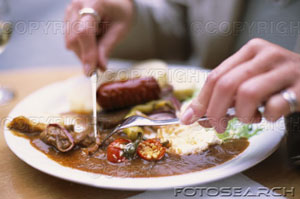 Food Flavor
Food Flavor The aroma of roast turkey. The sharp tang of aged New York cheddar. The smell of grilled onions. The sinus-clearing pleasure from a spicy salsa. Just the thought makes one's mouth water. If you're involved in designing savory products, one of the most important goals is to elicit the same response from the consumer. Due to the formulation restraints, processing and storage conditions most processed foods encounter, using special ingredients to achieve this goal becomes necessary.
Defining the exact meaning of savory flavor in a food product presents a challenge. Sometimes it refers to foods displaying brothy, or "umami" characteristics. Often, savory products are just categorized as non-sweet, although those working with teriyaki or similar flavors would certainly disagree. Typically, savory products contain meaty, brothy, cheese or vegetable notes; and although some may be flavored with sugar, the primary enhancer in the category is salt.
On the surface, the concepts used for flavoring meat and savory products look no different from flavoring products on the sweet side. Although this is true in many areas, designing these products requires a unique frame of reference. Savory flavors run the gamut from a fairly straightforward single flavor like "cheese" or "onion" to complex mixtures like "pepperoni pizza." The more complex the flavor, the more it becomes necessary to take an organized approach to designing the optimum flavor system. Many experts recommend breaking them down into basic components, which when put together, describe a whole, well-rounded flavor profile.
The typical base flavors used in savory products include meat and seafood, cheese, grains and vegetables. The flavors may come from the products themselves, be supplemented by various flavoring materials or even be provided by ingredients that reflect the appropriate flavor characteristics. They provide the general background rather than specifics -- cheese, rather than Monterey Jack. Typical base flavoring materials include: meat and seafood extracts and flavors, cheese powders, hydrolyzed vegetable protein (HVP), yeast extracts and vegetable purees, especially tomato. Often, as in the case of salty snacks and other grain-based products like pasta dishes, the "base material" is actually considered a carrier.
The first step is to determine whether the characterizing flavor needs intensifying. If you're working with a nice piece of beef for a premium entree, the answer is probably no. If you're working with chicken stock made by waving the proverbial chicken leg over the top, the product definitely will need a flavor boost and it's time to work with one of the flavoring materials mentioned.
Once the appropriate base flavor is identified, it's time to add characterizing flavor notes. The same materials work here, but added to the shelf are flavoring materials such as herbs and spices, vegetable extracts, condiments, natural and artificial flavor compounds, and similar ingredients. These further define the flavor. This changes the product from beef to grilled steak, from chicken soup to tam yum, or from buttermilk to zesty ranch.
Source: foodproductdesign.com
Food Flavor



